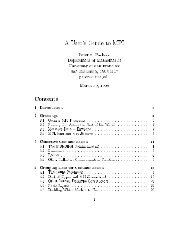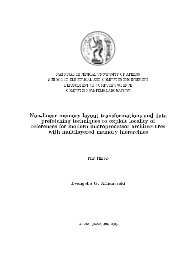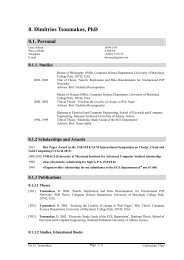Fast and Cost-Effective Online Load-Balancing in - Computing ...
Fast and Cost-Effective Online Load-Balancing in - Computing ...
Fast and Cost-Effective Online Load-Balancing in - Computing ...
Create successful ePaper yourself
Turn your PDF publications into a flip-book with our unique Google optimized e-Paper software.
KONSTANTINOU ET AL.: FAST AND COST-EFFECTIVE ONLINE LOAD-BALANCING IN DISTRIBUTED RANGE-QUERIABLE SYSTEMS 1361<br />
transferred <strong>and</strong> balanc<strong>in</strong>g is 2.2 times slower compared to<br />
the 760 sec <strong>and</strong> [15-21K] comb<strong>in</strong>ation.<br />
Fig. 17. Number of exchanged messages over time, dynamic sett<strong>in</strong>g.<br />
Fig. 18. Number of exchanged keys over time, dynamic sett<strong>in</strong>g.<br />
number messages does not exceed 700 msg/sec (<strong>in</strong> a 500-<br />
node sett<strong>in</strong>g) whereas the number of exchanged keys stays<br />
under 1,200 keys/sec (<strong>in</strong> a 50K sett<strong>in</strong>g). F<strong>in</strong>ally, the reason<br />
that the convergence time is documented to be larger than<br />
that of h<strong>and</strong>l<strong>in</strong>g a s<strong>in</strong>gle pulse is obvious: The very sudden<br />
change <strong>in</strong> skew forces the <strong>in</strong>validation of many already<br />
performed balance operations <strong>and</strong> nodes with no load<br />
problem suddenly become very overloaded.<br />
Fig. 19 shows the progress of the balanc<strong>in</strong>g process <strong>in</strong><br />
time: First, at time t ¼ 800 sec, after 100 sec of balanc<strong>in</strong>g<br />
time (recall that NIXMIG started at t ¼ 700 sec), just before<br />
the query load changes, we show that NIXMIG is very close<br />
to balanc<strong>in</strong>g the load. This is obvious from the improvement<br />
shown at t ¼ 850 sec, where the old pulse dim<strong>in</strong>ishes<br />
<strong>and</strong> the new one appears. After this po<strong>in</strong>t, the newly<br />
overloaded nodes start shedd<strong>in</strong>g load to their neighbors<br />
(hence the snapshot picture for time t ¼ 1;000 sec). F<strong>in</strong>ally,<br />
NIXMIG totally balances load (last image).<br />
In the follow<strong>in</strong>g experiment, we utilize the previously<br />
described 12 percent pulses <strong>and</strong> we modify the position <strong>in</strong><br />
the ID-space of the second pulse along with the time we<br />
trigger the sudden pulse move. At every execution, the <strong>in</strong>itial<br />
pulse is applied over items [10K,16K]. We present our results<br />
<strong>in</strong> Table 4. Each column represents an <strong>in</strong>crease <strong>in</strong> the second<br />
pulse’s distance from the <strong>in</strong>itial one us<strong>in</strong>g a 10 percent step of<br />
5K keys <strong>and</strong> each l<strong>in</strong>e an <strong>in</strong>crease <strong>in</strong> the time we trigger the<br />
sudden change us<strong>in</strong>g a step of 20 seconds. We measure the<br />
total number of exchanged items along with the time it took<br />
for NIXMIG to balance both workloads. We notice that as the<br />
new pulse’s distance <strong>in</strong>creases <strong>in</strong> each column, NIXMIG<br />
performs more key exchanges <strong>and</strong> takes more time to<br />
complete. The same <strong>in</strong>crease <strong>in</strong> both metrics is noticeable<br />
when, <strong>in</strong> each row we <strong>in</strong>crease the time we trigger the second<br />
pulse. Nevertheless, even <strong>in</strong> the worst case where the second<br />
pulse is triggered at t ¼ 820 sec (60 sec later compared to the<br />
760 sec case) <strong>and</strong> <strong>in</strong> the [30K-36K] position (40 percent<br />
further than <strong>in</strong> the [15-21K] case), NIXMIG’s performance is<br />
not significantly degraded: only 30 percent more items are<br />
5.4 Smart Remote Node Placement Mechanism<br />
Next, we study the effect of m<strong>in</strong>imiz<strong>in</strong>g the number of<br />
exchanged items dur<strong>in</strong>g load transfers caused by migrations<br />
by tak<strong>in</strong>g <strong>in</strong>to account load skew, as presented <strong>in</strong> Section 4.2.<br />
More specific, we compare our smart, skew-aware,<br />
remote node placement mechanism (hence SmartRNP) to<br />
the r<strong>and</strong>om case (hence R<strong>and</strong>omRNP) where nodes are<br />
r<strong>and</strong>omly placed <strong>and</strong> to the situation where an “adversary”<br />
places remote nodes so as to maximize the number of<br />
transferred items (hence AdversarialRNP). As our <strong>in</strong>put<br />
workload, we consider a number of (around 20) popular<br />
ranges <strong>in</strong> the ID space for which all keys are requested,<br />
whereas all other keys are not queried at all. We vary the<br />
width of each popular range so that all “hot” ranges occupy<br />
from 10 to 50 percent of the ID space. In Table 5, we present<br />
the effect of SmartRNP for various workloads (first column):<br />
<strong>in</strong> the second column, we depict the number of exchanged<br />
keys due to a MIG operation effectively m<strong>in</strong>imized by<br />
SmartRNP, <strong>in</strong> the third column, we present the ratio of<br />
SmartRNP to R<strong>and</strong>omRNP key movement <strong>and</strong> <strong>in</strong> the fourth<br />
column the ratio of SmartRNP to AdversarialRNP key<br />
movement. We notice that for highly skewed distributions<br />
of 10 percent, SmartRNP exchanges only 47 percent items<br />
compared to R<strong>and</strong>omRNP <strong>and</strong> 16 percent compared to the<br />
adversarial case, while this ratio <strong>in</strong>creases (i.e., SmartRNP<br />
number of transferred items gets closer to the number of<br />
R<strong>and</strong>omRNP <strong>and</strong> AdversarialRNP) for less skewed distributions.<br />
This is expla<strong>in</strong>ed by Fig. 8: the larger the skew, the<br />
larger the difference of jr 2 r b j from jr 1 r b j mak<strong>in</strong>g node<br />
A’s decision more critical for the algorithm’s performance.<br />
What is more, we notice that R<strong>and</strong>omRNP performs<br />
constantly better than AdversarialRNP (worst-case scenario)<br />
<strong>in</strong> terms of transferred items, as with high probability half of<br />
its decisions are “correct” (i.e., they m<strong>in</strong>imize key transfer).<br />
5.5 NIXMIG <strong>in</strong> Realistic Workloads<br />
In the follow<strong>in</strong>g experiment, we utilize a publicly available<br />
data set from AOL that conta<strong>in</strong>s 20 million queries from<br />
over 650,000 users over a three-month period. 2 The data set<br />
comprises around 3.7 million dist<strong>in</strong>ct keywords of vary<strong>in</strong>g<br />
popularity which are <strong>in</strong>itially equally divided among 500<br />
nodes. By measur<strong>in</strong>g the number of occurrences of each<br />
keyword <strong>in</strong> the searches, we calculated the query frequency<br />
distribution: Clients are generat<strong>in</strong>g prefix queries of<br />
variable length (e.g., “goo ”, “googl ”, etc.) based on the<br />
calculated frequencies. Prefix queries, typically used by<br />
search eng<strong>in</strong>es to provide the autocomplete feature among<br />
others, are translated to range queries <strong>in</strong> our setup.<br />
Compared to our previous reported experiments, nodes<br />
now store almost 100 times more objects ,while the query<br />
workload follows a realistic distribution, with the selectivity<br />
of the range queries tak<strong>in</strong>g many possible values.<br />
Table 6 presents the results for variable prefix lengths. In<br />
all cases, NIXMIG balances load fast <strong>and</strong> under 150 sec, a<br />
result that is well <strong>in</strong>l<strong>in</strong>e with our previous f<strong>in</strong>d<strong>in</strong>gs (see<br />
Section 5.1—first graphs of Figs. 9 <strong>and</strong> 10). NIXMIG adapts its<br />
operations to the applied workload: When the prefix length<br />
2. http://techcrunch.com/2006/08/06/aol-proudly-releases-massiveamounts-of-user-search-data/.











